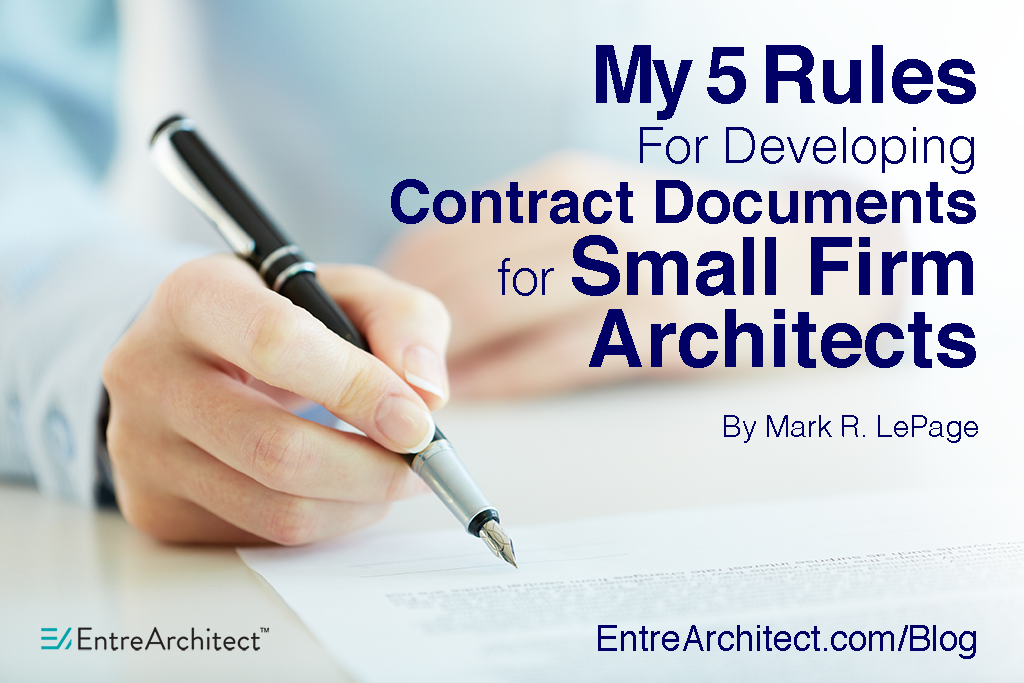It may be the most critical step in the entire process of acquiring a new architecture client.
We may have perfected our marketing, developed a strong reputation, executed a flawless sales process and have received our prospective client’s eager authorization to proceed with a new project. We may have done everything right and find ourselves at the point where, to make this new relationship official, we need a signed legal document.
We need a contract.
Hand shakes are only as good as your memory (or your luck) may be. Simple letters of agreement may define the project description and manage an understanding for how to get paid, but will only be as valuable as the paper that they are printed upon if there is a mis-understanding or a conflict somewhere down the line.
Send your client an overwhelmingly comprehensive legal agreement intended for large projects and it may end up on an attorney’s desk waiting for review and revision (or in many cases, a complete re-write). Fear of the unknown and a lack of knowledge will give your client no other choice… and lots of additional time to reconsider moving forward with your project.
Every project we perform as professionals must be commenced with a signed written agreement, but for small firm architects working with inexperienced clients, this is a critical moment. This one step could kill the project before you ever have a chance to demonstrate your skill as an architect.
5 Rules For Developing Contract Documents for Small Firm Architects
It’s your proposal. They’re your contract documents… with your client.
These five rules will show you how to develop an Owner/Architect Agreement contract documents package that will serve and protect you (and your client), without scaring them away.
1. Comprehensive is critical.
The big scary contracts offered by some professional organizations look that way because they include information and language for every possible situation. Fine print allows for more words, describing every responsibility and clarifying any and all processes required to complete any architectural project.
There is a good reason for that. In a world where the rules for the architecture profession are established and written by the legal profession, it is important that your agreement includes all the information necessary to define your services and quickly resolve any conflict that may occur along the way.
A comprehensive document is critical, but our goal is to get that document signed so we can get started doing what we love… designing a great project for our new client.
2. Minimize the steps to “yes”.
Traditionally an architect will send a prospect a proposal letter, which will include a description of the basic services and general “terms and conditions” for the project. Then, upon approval of the proposal, a second formal legal agreement between owner and architect is prepared and sent for additional review and approval.
With each step of the process, the client is considering (and reconsidering) their decision to move forward with you as their architect. Preparing one document package that acts as both the proposal and the legal agreement, will minimize the steps to get to “yes”.
3. Make it “client friendly”.
Although we must include a vast amount of information for our legal agreements to be effective and complete, they don’t need to look intimidating or aggressive. These documents are the beginning of a wonderful relationship between us and our client.
We are architects. We have a unique ability to take the complex and make it look beautiful. Spend time designing your Owner/Architect Agreement, so it is simple to read and is easily understood.
4. Break it down.
A simple way to make an intimidatingly long legal document look friendlier, without losing its effectiveness, is to break it down into several different parts. Consider developing a complete package of documents which may include a cover letter, a proposal, separate “terms and conditions” and a list of client references.
The cover letter thanks your prospective client for considering you for the job, a quick description for what is included in the package and a clear “call to action” upon their approval of the enclosed documents.
A well designed, friendly looking, larger-font proposal document will describe the process you will perform, the basic responsibilities of the client and a clear method of compensation.
The “Standard Terms and Conditions for Architectural Services” is a one or two page document that includes all the legal information specific to your services. Your terms and conditions may include anything you want. It’s your document, but it is presented in a way that makes it appear that your terms and conditions are “standard” to the profession. This results in a signed agreement returned to your office in less time.
5. Don’t go it alone.
It’s your document. You are designing it. You are writing it. It should include all the information you want and none of which you don’t. With that all said… don’t go it alone. Have your attorney and your insurance company review all your legal documents. Be sure that it meets with all the legal requirements and protective possibilities for the jurisdiction in which you practice.
We all want an Owner/Architect Agreement that will smooth out the process for procuring your best projects, but we don’t want to discover that what we have developed is no better than a handshake in the eyes of the authorities.
More than a decade ago, I wrote an Owner/Architect Agreement package for my own small firm. I followed these five rules and have used our documents with hundreds of prospective projects. Since we have the ability to continuously improve our systems, it’s been teased, tweaked and tested throughout the years. Project after project it performs its duty by keeping the process clear and by providing us (and our clients) with the confidence that we are all protected. Year after year, we move from proposal to project in less time with happier clients.
Question: Have you developed your own Owner/Architect Agreement?
 My Hybrid Proposal Course will show you how to develop an Owner/Architect agreement for your small firm architecture studio. It comes complete with ready-to-edit document templates, so you can get up and running with your new document package in just a few minutes.
My Hybrid Proposal Course will show you how to develop an Owner/Architect agreement for your small firm architecture studio. It comes complete with ready-to-edit document templates, so you can get up and running with your new document package in just a few minutes.
Click here to order EntreArchitect Hybrid Proposal now.
Photo Credit: Shutterstock / Pressmaster


Leave a Reply